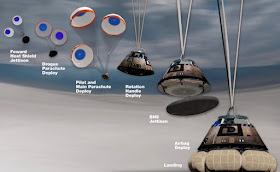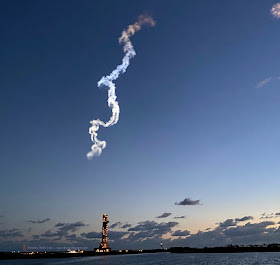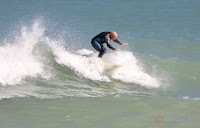[
Grimentz, Wallis, Switzerland, August 16, 2019.
English below] – Je reprends la plume après mon dernier périple aux USA. Suite au lancement de la fusée NASA/SpaceX CRS-18, j'ai eu l'occasion de donner une conférence aux Grisons, puis une interview pour le Matin online sous la plume de Vincent Donzé, dont j'ai traduit son texte en anglais pour mon lectorat d'Outre Atlantique. Voici donc la suite de mes trips.
 |
| Mon collègue, le Prof. Dr Thomas Schildknecht en conférence devant les jeunes de JULA19 le 31 juillet 2019 aux Grisons. - Photo :rke |
[Courtedoux, Jura, Switzerland August 5, 2019] – L'article du Matin online:
IL PASSE SA VIE À REGARDER DÉCOLLER LES FUSÉES
Seul photographe suisse accrédité sur les pas de tir, Roland J. Keller a assisté à 30 lancements.
Grisons : conférence avec des collègues renommés
[
S-Chanf (Graubünden) July 31, 2019] - Comme ce fut le cas lors de trois autres interventions, j'ai eu la chance et l'occasion le 31 juillet dernier de donner une conférence au Camp de Jeunesse de la Fondation ProAéro chapeauté par l'Aéro-Club de Suisse. Son but : rapprocher les participants de l'univers du vol, et d'éveiller leur enthousiasme. Il leur est donné autant une introduction à la théorie et à la pratique du vol au travers de travaux manuels ludiques, que des informations sur toutes les branches de l'aéronautique, ainsi qu'une vue d'ensemble de ses métiers. Tous ces jeunes, des ados un peu geek d'aviation et le nez au nez ciel, sont nourris et logés à moindre coût. L'encadrement des écolières et écoliers, dans des groupes de max 16 jeunes environ, est assuré par des monitrices et moniteurs expérimentés. Il paraît que même Claude Nicollier est passé par là dans sa jeunesse.
Mandaté par la SRV
 |
| Mon collègue devant les jeunes de JULA 19. - Photo : rke |
Engagé par l'Association Spatiale Suisse (SRV) sous l'égide de l’Académie suisse des sciences techniques (SATW), j'ai donc eu l'occasion de parler – pour la 4e fois consécutive – des avions de l'espace devant une trentaine de jeunes romands très, mais alors très euphoriques ! Ce qui ne m'a pas déplu, évidemment. Comme je rentrais de mon dernier trip des USA, j'ai pu ramener du matériel pour lancer un concours (1er prix : un t-shirt avec lunettes 3D, 2e prix : un stylo spatial) qui a connu un vif succès. J'étais accompagné par Jörg Sekler (initiateur du concours), président de la SRV et professeur émérite de la Haute École d'Ingénierie (FHNW) qui m'a secondé dans mon speech. Il a d'ailleurs eu la chance d'être un invité spécial de la NASA à Cap Canaveral au lancement de la mission Apollo-Soyuz en 1975.
Mes deux autres collègues, le Prof. Dr Thomas Schildknecht (astrophysicien à l'Université de Berne, UNIB) et le Dr Emiliano Cordelli (de l'UNIB également) ont respectivement donné une conférence en allemand et en italien dans d'autres salles. J'étais donc fier d'être entouré par des personnalités de cette renommée et de pouvoir m'exprimer devant cette jeunesse !
Flash-back sur mon 30e lancement accrédité
 |
The launch of NASA/SpaceX CRS-18
on July 25, 2019. - Photo : rke |
[Cap Canaveral, July 25, 2019] – Bonne tactique. Ce n’est pas faute d’avoir loupé un lancement le premier jour, le 24 juillet 2019,en raison d’une météo orageuse et instable (alors 30% de chances de réussite), qu’il faut renoncer de tenter le coup au deuxième jour aux mêmes conditions. On en a eu la preuve ce jeudi 25 juillet. À midi, il pleuvait des gouttes incessantes sur le centre spatial. De gros nuages foncés se sont même amoncelés sur le pas de tir, et voilà que tout à coup, une heure avant le lancement, le ciel s’est dégagé.
Eh, que voulez-vous, c’est la Floride ! Je me suis donc rendu, toujours le seul reporter accrédité, sur la désormais classique très longue route surveillée NASA Causeway accompagné d’une trentaine de photographes. Nous y sommes allés cette fois avec un seul bus. On y a posé nos appareils à photos et caméras le long d’une lagune en vue directe (3 miles ou 5 km le plus près) de la fusée Falcon que nous avons très nettement distinguée. Comme je le relate dans un précédent décollage (cliquez ici), lors d'un lancement, on se rend mieux compte des efforts que des humains (ingénieurs, mécanos, planificateurs, administrateurs, partenaires) ont dû fournir pour être prêts à l’heure « H ». Car quand la fusée s’élève à peine, c’est non seulement la vision d’un engin qui décolle, mais un condensé d’efforts qui éclôt. Et lors retour sur Terre, c'est comme une épée de Damoclès sur nos têtes.
Cape Canaveral (Florida) – Graubünden (Switzerland) : aeronautical rejuvenation cure
[
Grimentz, Wallis, Switzerland, August 16, 2019] - I take up writing again after my last trip to the USA. Following the launch of the NASA/SpaceX CRS-18 rocket, I had the opportunity to give a lecture in Graubünden, then an interview for Le Matin online written by Vincent Donzé, for which I translated his text into English below. So here is the rest of my trips.
[Courtedoux, Jura, Switzerland August 5, 2019] - The article in Le Matin online:
Roland J. Keller, the only Swiss photographer accredited on the shooting ranges, attended 30 launches.
Thirty accredited launches: at 62 years of age, Jura journalist Roland J. Keller beats European records in aeronautics. More precisely in aeronautical observation: this engineer is the only Swiss photographer accredited on shooting ranges (NASA/ESA/SpaceX) since... 1981! At Cape Canaveral, Roland J. Keller saw it all: the first and last flight of a space shuttle, the launch of Waldensian astronaut Claude Nicollier, the Challenger disaster...
Five kilometres away
When a million spectators attend a launch, Roland J. Keller is the closest to the launch pad, five kilometers away, with one hand under his telephoto lens while chasing mosquitoes... "The audience that holds its breath is a silent atmosphere that always gives adrenaline, with the fear of an explosion," explains this observer marked by Challenger. "Twenty seconds after takeoff, the sound comes to us, very shrill, with 3000 tons of thrust," says the Jura engineer. But the hidden side of a launch also impresses him: "What is happening before my eyes is the result of a lot of work for thousands of people".
At his grandmother's house
Nothing predestined this child of Pleigne (JU) to stick his nose in the stars. Except that at the age of 13, on the night of July 20-21, 1969, he watched the moon landing at his grandmother Léontine's house, which had a small portable TV. The moon landing served as a trigger: schooled in Delémont, he started making models and became passionate about Apollo missions. At 13, he signed up for a trip to Cape Canaveral, via Radio TV8 magazine....
By opening the mail, his mother believes that he is invited to the launch of Apollo 13, without realizing that the trip is at his own expense: Roland returned the coupon for the sole purpose of receiving the documentation... At his home in Courrendlin (JU), an entire cellar is filled with it.
Special Envoy
His first trip as a special envoy was in 1981. Roland J. Keller became a mechanical engineer and correspondent for the Jura daily newspaper "Le Démocrate", and launched the Astropresse space agency into orbit in 1986. Together with the European Space Agency, he is the only one on the continent to obtain photos from the laboratory in Houston, Texas. A flight in Concorde in 1987, another in Hunter with Claude Nicollier in 2011, a flight in Zero G on the Mediterranean in 2016, but Roland J. Keller is not a fanfarer: met this week at the former Courtedoux airfield (JU), he describes his experiences as "privileges".
Twice the wall
"A flight in Concorde, twice the sound barrier, it was all the more crazy as the pilot was talking to me while looking at me... without risk of crossing another plane, at an altitude of 20,000 meters," says Roland J. Keller. The Hunter flight with Claude Nicollier also marked him: "The Valais found itself above us: my pilot had just made a blocked barrel...".
But the flight that shocked him was the one in weightlessness, at Zero G, in a plane that fell into a spin while performing parables: "Ecstasy for 32 seconds, like therapy..." blows this passionate man who has no pilot's license. "Being a reporter in space, yes! But pilot, no...", he smiles.
At the funeral
The Jura journalist has been accredited for so long that almost all doors are open to him. In 2012, he attended the funeral of Neil Armstrong, the first man to walk on the moon. Virgin Galactic (2013), Mission Jupiter (2016), ESA Orion module (2018): it has access to the main American stages of space exploration. And when he's not there, NASA worries: "Why didn't you come? Are you sick?".
A little Swiss boy
His modesty takes over: "They like to know what a little Swiss man thinks of a big American rocket," says Roland J. Keller, editor-in-chief of "Swiss Engineering" magazine for the past twelve years.
His blog has found a mainly American audience. Roland J. Keller is ready to return to his second homeland, via Miami and Orlando, towards Cape Canaveral. Not for a vacation: "I work more there than here," he says. His wife and daughter let him do it: their passion is riding.
Graubünden: conference with high-profile colleagues
 |
My colleague, Prof. Dr. Thomas Schildknecht, in a conference
in front of the young people of JULA19 on 31 October 2019
in Graubünden. - Photo : rke |
S-Chanf (Graubünden), Switzerland, July 31, 2019] - As in three other interventions, I had the opportunity and the opportunity on July 31 to give a lecture at the ProAero Foundation Youth Camp hosted by the Aero Club of Switzerland. Its goal: to bring participants closer to the world of flight, and to awaken their enthusiasm. They are given an introduction to the theory and practice of flight through fun manual work, as well as information on all branches of aeronautics, and an overview of its professions. All these young people, teenagers a bit of an aviation geek and with their noses to the sky, are fed and housed at a lower cost. The supervision of the pupils, in groups of max. 16 young people, is provided by experienced instructors. It seems that even Claude Nicollier went through this in his youth.
 |
My colleague, Dr. Emiliano Cordelli, in a conference in front
of the young people of JULA19 on 31 October 2019 in Graubünden. |
Engaged by the Swiss Space Association (SRV) under the aegis of the Swiss Academy of Technical Sciences (SATW), I had the opportunity to speak - for the 4th consecutive time - about rocket planes in front of about thirty very, but then very euphoric young people from French-speaking Switzerland! Which I didn't dislike, of course. As I was returning from my last trip from the USA, I was able to bring back some equipment to launch a contest (1st prize: a t-shirt with 3D glasses, 2nd prize: a space pen) which was a great success. I was accompanied by Jörg Sekler (initiator of the competition), President of the SRV and Professor Emeritus of the University of Applied Sciences (FHNW) who assisted me in my speech. He was fortunate enough to be a special guest of NASA in Cape Canaveral at the launch of the Apollo-Soyuz mission in 1975.
My two other colleagues, Prof. Dr. Thomas Schildknecht (astrophysicist at the University of Bern, UNIB) and Dr. Emiliano Cordelli (also from UNIB) gave a lecture in German and Italian respectively in other rooms. I was therefore proud to be surrounded by such renowned personalities and to be able to express myself in front of this youth!
Flash back on my 30th accredited launch
 |
Shortly before the launch of NASA/SpaceX CRS-18
on July 25, 2019. - Photo : rke |
[Cape Canaveral, July 25, 2019] - Good tactics. It is not for lack of having missed a launch on the first day, July 24, 2019, due to stormy and unstable weather (then 30% chance of success), that you have to give up trying on the second day under the same conditions. We received proof of this on Thursday, July 25. At noon, it was raining incessantly on the space center. Large dark clouds even gathered on the launch pad, and suddenly, an hour before the launch, the sky cleared.
Hey, what do you want, it's Florida! So I went, still the only accredited reporter, on the now classic very long supervised NASA Causeway road with about thirty photographers. This time we went there with only one bus. We placed our cameras and cameras along a lagoon in direct view (3 miles or 5 km closest) of the Falcon rocket, which we distinguished very clearly. As I recounted in a previous takeoff (click here), during a launch, we get a better idea of the efforts that humans (engineers, mechanics, planners, administrators, partners) had to make to be ready at the "H" time. Because when the rocket barely rises, it is not only the vision of a machine that takes off, but a condensed version of efforts that hatches. And when we return to Earth, it's like a sword of Damocles on our heads.
Roland J. Keller, der einzige auf den Schießständen akkreditierte Schweizer Fotograf, nahm an 30 Starts teil.
Dreissig akkreditierte Launches: Mit 62 Jahren schlägt der Jurajournalist Roland J. Keller europäische Rekorde in der Luftfahrt. Genauer gesagt in der aeronautischen Beobachtung: Dieser Ingenieur ist der einzige Schweizer Fotograf, der seit seiner Gründung auf Schießständen (NASA/ESA/SpaceX) akkreditiert ist..... 1981!
Am Cape Canaveral sah Roland J. Keller alles: den ersten und letzten Flug eines Space Shuttle, den Start des waldensischen Astronauten Claude Nicollier, die Challenger-Katastrophe.....
Fünf Kilometer entfernt
Wenn eine Million Zuschauer an einem Start teilnehmen, ist Roland J. Keller der Startrampe am nächsten, fünf Kilometer entfernt, mit einer Hand unter seinem Teleobjektiv, während er Moskitos jagt.....
"Das Publikum, das den Atem anhält, ist eine stille Atmosphäre, die immer Adrenalin spendet, mit der Angst vor einer Explosion", erklärt dieser von Challenger geprägte Beobachter.
"Zwanzig Sekunden nach dem Start kommt das Geräusch zu uns, sehr schrill, mit 3000 Tonnen Schub", sagt der Jurainterieur. Aber auch die verborgene Seite eines Launches beeindruckt ihn: "Was vor meinen Augen passiert, ist das Ergebnis einer Menge Arbeit für Tausende von Menschen".
Im Haus seiner Großmutter
Nichts prädestinierte dieses Kind von Pleigne (JU) dazu, seine Nase in die Sterne zu stecken. Nur dass er im Alter von 13 Jahren, in der Nacht vom 20. auf den 21. Juli 1969, die Mondlandung im Haus seiner Großmutter Léontine mit einem kleinen tragbaren Fernseher beobachtete.
Als Auslöser diente die Mondlandung: In Delémont ausgebildet, begann er mit dem Modellbau und wurde leidenschaftlicher Anhänger der Apollo-Missionen. Mit 13 Jahren meldete er sich für eine Reise nach Cape Canaveral an, über die Zeitschrift Radio TV8.......
Mit dem Öffnen der Mail glaubt seine Mutter, dass er zum Start von Apollo 13 eingeladen ist, ohne zu merken, dass die Reise auf eigene Kosten erfolgt: Roland hat den Gutschein ausschließlich zum Zwecke des Erhalts der Unterlagen zurückgegeben..... In seinem Haus in Courrendlin (JU) ist ein ganzer Keller damit gefüllt.
Sonderbeauftragter
Seine erste Reise als Sonderbeauftragter fand 1981 statt. Roland J. Keller wurde Maschinenbauingenieur und Korrespondent der Juratageszeitung "Le Démocrate" und startete 1986 die Raumfahrtagentur Astropresse im Orbit. Zusammen mit der Europäischen Weltraumorganisation ist er der einzige auf dem Kontinent, der Fotos aus dem Labor in Houston, Texas, erhält.
Ein Flug in der Concorde 1987, ein weiterer in Hunter mit Claude Nicollier 2011, ein Flug in Zero G am Mittelmeer 2016, aber Roland J. Keller ist kein Fanfarmer: Diese Woche auf dem ehemaligen Flugplatz Courtedoux (JU) getroffen, beschreibt er seine Erfahrungen als "Privilegien".
Doppelte Wand
"Ein Flug in der Concorde, doppelt so hoch wie die Schallmauer, war umso verrückter, als der Pilot mit mir sprach, während er mich ansah.... ohne das Risiko, ein anderes Flugzeug zu überqueren, in 20.000 Metern Höhe", sagt Roland J. Keller.
Der Jägerflug mit Claude Nicollier markierte ihn auch: "Das Wallis befand sich über uns: Mein Pilot hatte gerade ein blockiertes Fass gemacht....".
Aber der Flug, der ihn schockierte, war derjenige in der Schwerelosigkeit, bei Zero G, in einem Flugzeug, das bei der Aufführung von Gleichnissen in einen Trudel stürzte: "Ecstasy für 32 Sekunden, wie Therapie...." bläst diesen leidenschaftlichen Mann, der keinen Führerschein hat. "Ein Reporter im Weltraum zu sein, ja! Aber Pilot, nein....", lächelt er.
Auf der Beerdigung
Der Jurajournalist ist schon so lange akkreditiert, dass ihm fast alle Türen offen stehen. Im Jahr 2012 nahm er an der Beerdigung von Neil Armstrong teil, dem ersten Mann, der auf dem Mond ging.
Virgin Galactic (2013), Mission Jupiter (2016), ESA Orion Modul (2018): Es hat Zugang zu den wichtigsten amerikanischen Phasen der Weltraumforschung. Und wenn er nicht da ist, macht sich die NASA Sorgen: "Warum bist du nicht gekommen? Bist du krank?".
Ein kleiner Schweizer Junge
Seine Bescheidenheit übernimmt: "Sie wissen gerne, was ein kleiner Schweizer von einer großen amerikanischen Rakete hält", sagt Roland J. Keller, Chefredakteur der Zeitschrift "Swiss Engineering" in den letzten zwölf Jahren.
Sein Blog hat ein hauptsächlich amerikanisches Publikum gefunden. Roland J. Keller ist bereit, in seine zweite Heimat zurückzukehren, über Miami und Orlando, Richtung Cape Canaveral. Nicht für den Urlaub: "Ich arbeite dort mehr als hier", sagt er. Seine Frau und seine Tochter ließen es ihn tun: Ihre Leidenschaft ist das Reiten.





















































